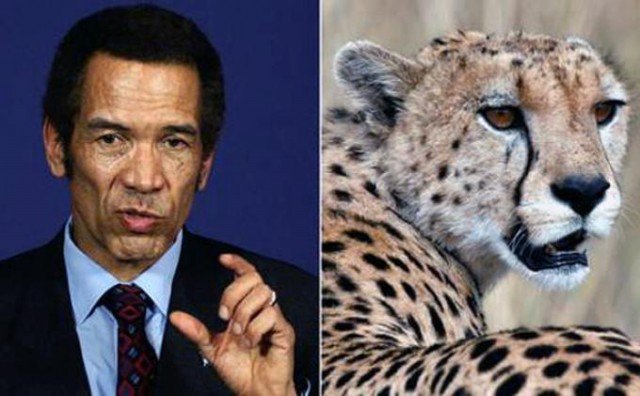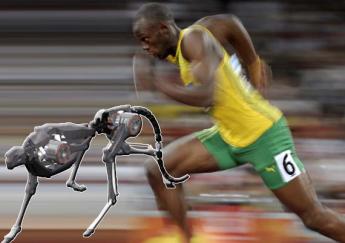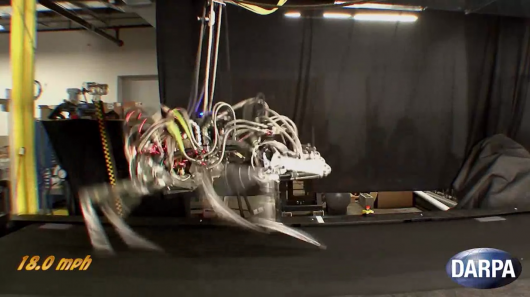Home Tags Posts tagged with "cheetah"
cheetah
Botswana President Ian Khama needed stitches on his face after being scratched by a cheetah, officials say.
The animal was reportedly being fed in its enclosure at an army barracks when it jumped up and scratched Ian Khama, who was standing nearby.
The incident was “a freak accident, but not an attack”, government spokesman Jeff Ramsay told local media.
Ian Khama’s injuries were minor and there were “no real security implications”, the official added.

Botswana President Ian Khama needed stitches on his face after being scratched by a cheetah
The incident is said to have happened very fast, catching the president and his bodyguard by surprise.
“He was scratched by a cheetah but not really attacked per se,” said Jeff Ramsay.
Ian Khama was seen sporting a plaster at a meeting following the attack.
Cheetahs, the world’s fastest land mammals, are listed as an endangered species.
Around 12,400 are thought to remain in the wild in African countries, including Botswana.
Cheetah robot has set a new world speed record for legged robots, running faster than Usain Bolt, who is considered the fastest human.
The headless machine, funded by the Pentagon, reached 28.3 mph (45.5 km/h) when tested on a treadmill.
Jamaican sprinter Usain Bolt’s top speed is 27.78 mph (44.7 km/h).
The project is part of efforts to develop robots for military use. One robotics expert said that it was “unfortunate” the Cheetah was made primarily “to kill people”.
It has been created by the Massachusetts robotics company Boston Dynamics and backed by the US Defense Advanced Research Projects Agency (DARPA).

Cheetah robot has set a new world speed record for legged robots, running faster than Usain Bolt
According to DARPA, the aim is to “more effectively assist war fighters across a greater range of missions”.
The Cheetah, which is powered by a hydraulic pump, broke its own record of 18 mph (29 km/h), recorded in February.
“The Cheetah had a slight advantage over Bolt as it ran on a treadmill, but most of the power Cheetah used was to swing and lift its legs fast enough, not to propel itself forward,” DARPA said in a statement.
The agency plans to test the robot in the field in 2013.
The machine’s design has been inspired by the real cheetah, the fastest land animal, which can reach speeds of 75 mph (121 km/h).
“Cheetahs happen to be beautiful examples of how natural engineering has created speed and agility across rough terrain,” said Gill Pratt, DARPA programme manager.
“Our Cheetah bot borrows ideas from nature’s design to inform stride patterns, flexing and unflexing of parts like the back, placement of limbs and stability.”
“What we gain through Cheetah and related research efforts are technological building blocks that create possibilities for a whole range of robots suited to future Department of Defense missions.”
Noel Sharkey, professor of artificial intelligence and robotics at the University of Sheffield, has mixed feelings about the development.
“It’s an incredible technical achievement, but it’s unfortunate that it’s going to be used to kill people,” he suggested.
“It’s going to be used for chasing people across the desert, I would imagine. I can’t think of many civilian applications – maybe for hunting, or farming, for rounding up sheep.
“But of course if it’s used for combat, it would be killing civilians as well as it’s not going to be able to discriminate between civilians and soldiers.”
DARPA’s press release for the Cheetah project suggested that the robots might ultimately be used in “emergency response, humanitarian assistance and other defence missions”.
[youtube 43p6A4ku7k8]
Japanese researchers mapped the muscles fibres of cheetah known to accelerate to record-breaking speeds.
By comparing the cheetah’s muscles with those of a domestic cat and dog, the team identified the special propulsion power of its hindlimb muscles.
The study is the first to investigate muscle fibre distribution across the whole of the cheetah’s body.
The findings are published in the journal Mammalian Biology and examine how the muscle fibres of domestic cats and dogs compare with those of the world’s fastest land mammal.
“The study of muscles is indispensable to understand the cheetah’s run,” said Dr. Naomi Wada, the study’s co-author and Professor in System Physiology at Yamaguchi University in Japan.

Japanese researchers mapped the muscles fibres of cheetah known to accelerate to record-breaking speeds
Different types of muscle fibre are suited to different activities, explained Dr. Naomi Wada.
In all the animals studied, so-called Type I fibres produced a small force output but were resistant to fatigue, making them best suited to maintaining posture and slow walking.
Type IIa fibre performance was best suited to fast walking and trotting whereas Type IIx or “fast” fibres created a high force output but had low endurance and were key to fast running or galloping.
By mapping the distribution of fibres across the muscles of a cheetah’s body, scientists were able to gain insights into the animal’s impressive sprint technique.
“The forelimb muscles in the cheetah included [the] most Type I muscle fibres of all three animals… while the muscle of hind limb muscles have many Type IIx fibres.”
“The functional difference between forelimb and hindlimb is the most remarkable in the cheetah,” said Dr. Naomi Wada.
The team’s results suggested that the power comes from the cheetah’s hind legs, in the same way as a rear wheel-drive car, according to Dr. Naomi Wada.
She drew a further automative parallel when describing how the cheetah handles at high speed.
The digits of the cheetah’s hindlimbs contained no fast fibres, but the digits on the front legs contained many of them.
Dr. Naomi Wada explained that this is because the cheetah controls its balance by using its forefeet to turn and slow down.
However, most rear-wheel drive cars cannot mimic the enviable acceleration of the cheetah: zero to 60 mph in under three seconds.
Previous studies have indentified the cat’s seven metre stride-length as key to this ability. With long, flexible limbs, a sprinting cheetah spends more than half its time airborne.
In order to maximize this effect, it arches and contracts its spine, and Dr. Naomi Wada and colleagues found muscle fibres that supported this technique.
The cat had a high percentage of fast fibres running along its back and middle, suggesting that it could produce a quick, strong extension of the backbone.
[youtube S-zcA_mOa94]
Cheetah, a four-legged and headless robot, has set a new world speed record, according to the US Defense Advanced Research Projects Agency (DARPA).
DARPA said Cheetah achieved 18 mph (29 km/h) on a laboratory treadmill and the previous land speed record by a legged robot was 13.1 mph.
The agency said that the project was part of efforts to develop robots designed to “more effectively assist war fighters across a greater range of missions”.
DARPA – which is run by the Pentagon – funded the Massachusetts robotics company Boston Dynamics to build the machine.
“We plan to get off the treadmill and into the field as soon as possible,” said the firm’s chief robotics scientist, Alfred Rizzi, in a statement.
“We really want to understand what is possible for fast-moving robots.”

Cheetah, a four-legged and headless robot, has set a new world speed record, according to DARPA
The robot’s movements have been modeled on those of fast-running animals in the wild. The machine is designed to flex and un-flex its back to increase the length of its stride.
The current version of Cheetah is dependent on an off-board hydraulic pump, requiring one of the researchers to hold the tubing out of its way. However, the researchers said a free-running prototype was planned for later this year.
The four-year project, which was commissioned in February 2011, ultimately aims to deliver a robot which can “zigzag to chase and evade”, and be able to come to an abrupt halt.
It builds on other models based on animals created by Boston Dynamics including its BigDog rough-terrain robot, designed to recycle energy from one step to the next, and its lizard-like Rise, which can climb walls, trees and fences by using micro-claws on its six feet and a tail for balance.
[youtube d2D71CveQwo]




